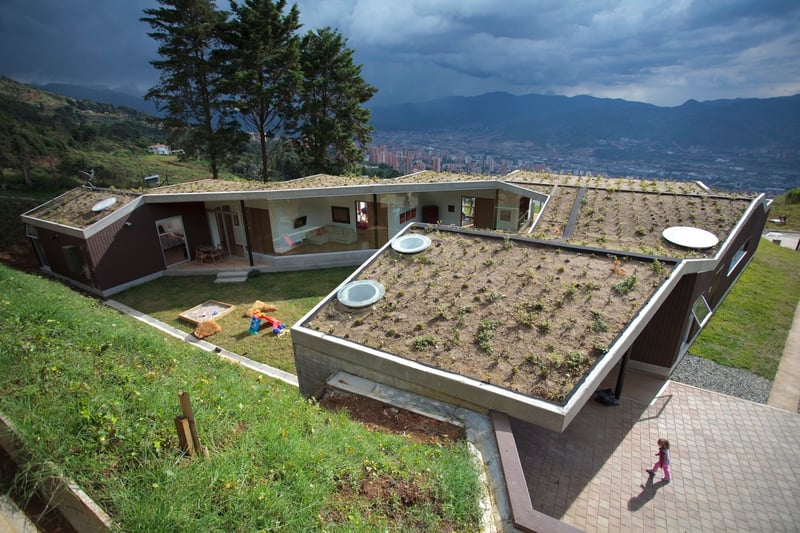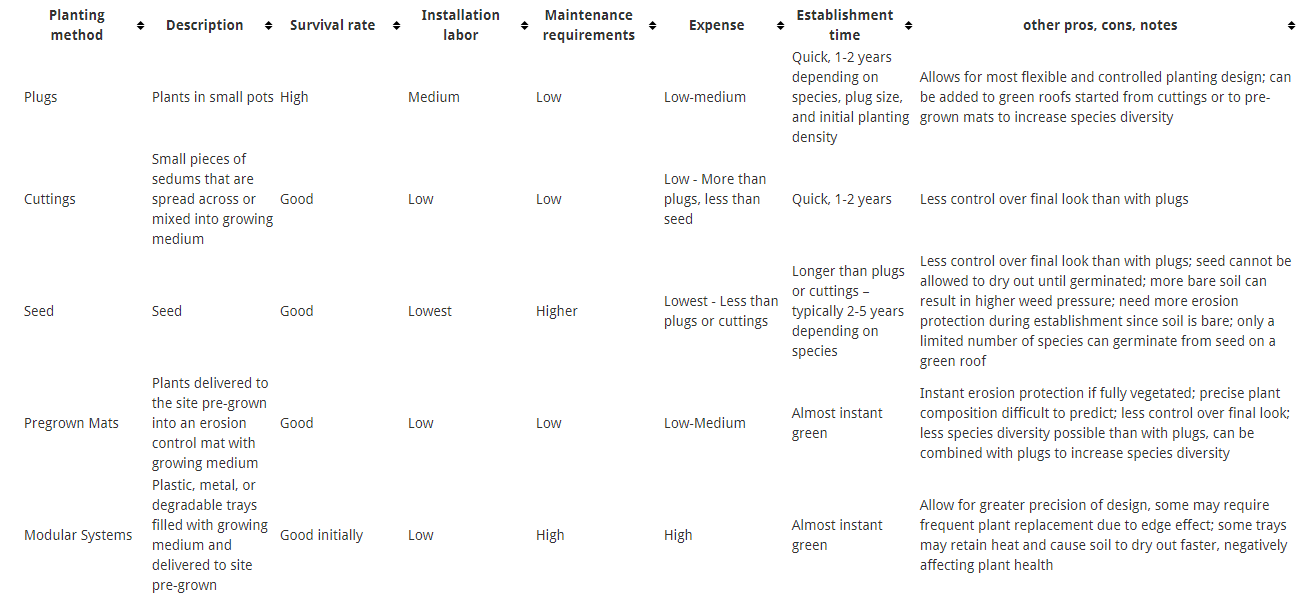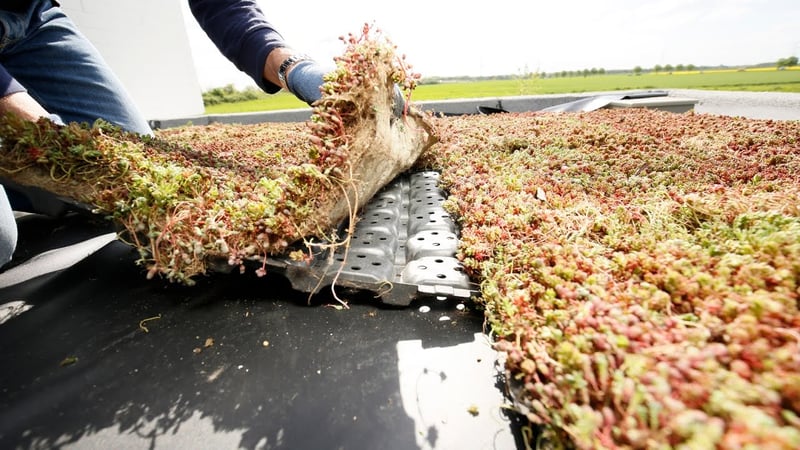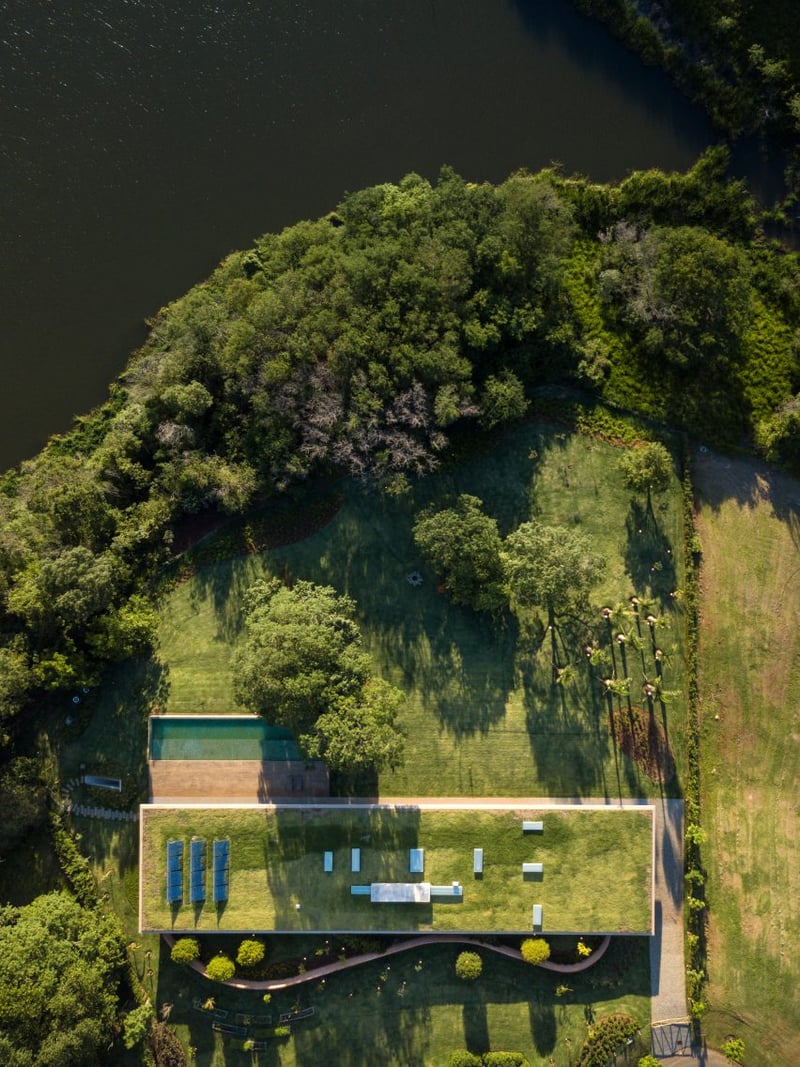Green roofs can be installed by method of planting it with sedum cuttings and/or plugs, or by using a vegetation blankets, mats or rolls, that have been pre-prepared to be installed. There are, of course, factors that influence the use of ether one or the other – project size, cost, project time-frame, maintenance and watering limitations, roof slope and other possible elements. The following is an overview of both methods in order to establish a framework for informed decision-making.
Green Roofs with Sedum Cuttings and Plugs
When using this method, the ultimate appearance of the project depends on the quality of the planting – the distribution of cuttings, rolling and watering after spreading. A lot of care goes into maintaining the roof during the phase when the plants are being established. In this period, it is essential to provide consistent irrigation (3). Planting only takes place during the spring or autumn months due to the availability of cuttings or plugs (2). The method calls for the installer to spread out the cuttings well over the whole of the surface area, roll the surface area in order to facilitate contact between the cutting and the surface of the growing medium, and after that, water regularly. The sedum cutting planting technique can be enhanced by combining it with planting micro-plug plantings, yet multilayer planting solutions involving sowing are not suitable for roofs with a steep pitch over 20% (3). In their first year, the young plants need a lot of care and help growing up, taking an average 2-3 years to establish fully. Cuttings also need more soil, which means that a minimum substrate layer of 7-8 cm is required. Too much substrate can encourage weeds to grow on the almost empty substrate and take over the roof, adding weeding to maintenance tasks. Additionally, the weight of both the substrate and fully developed plants must be taken into account when planning a roof with cuttings, making them about 60% heavier than green roofs with vegetation blankets. Initially, heating and wind erosion can also pose some concern as 95% of the substrate on roofs with plug plants or cuttings is initially exposed. The substrate is largely made up of a mixture of pebbles that can be blown off by strong gusts of wind (2).
 Image 1: A green roof with cuttings in its early stage. Casa M / Plan:b arquitectos, photo: Sergio Gomez
Image 1: A green roof with cuttings in its early stage. Casa M / Plan:b arquitectos, photo: Sergio Gomez
Despite the easier and faster establishment of sedums in the form of vegetated blankets, rolls or mats, the direct spreading of cuttings is still an interesting cost-effective installation method for large-scale roofs. Cutting establishment, however, might take some extra involvement and care to ensure maximum survival rate of the plants (1).

Table 1: Comparison of most common extensive green roof planting methods (4)
Instant Green Roofs
Instant green roofs usually appear as modular systems in trays or as vegetated blankets, mats or rolls. All of those refer to a pre-vegetated surface that can be installed directly and assume their final form instantly. Because green roofs with vegetation blankets require less substrate (approximately 5 cm), their weight is also considerably lower. Vegetation blankets can be installed all year round - even during winter months, except when it is freezing. Because they are pre-grown, the plants on the vegetation blankets are already about a year old and their roots have already established. After installation, the blankets are low maintenance and hardly allow any weeds to grow. They suffer very little wind erosion because the underlying substrate is covered entirely by the vegetation. Contrary to green roofs with plugs or cuttings, green roofs with vegetation blankets allow you to enjoy the advantages that green roofs provide straight away, reducing heat in the summer, providing insulation in winter and taking their final appearance immediately (2). In vegetated blankets however, precise plant composition is usually pre-determined. This gives the planner less control over final look. Vegetated blankets can usually provide less plant diversity than is achievable with cuttings or plugs, yet some can be combined with plugs to increase species diversity. Modular systems allow for greater precision of design, yet some may require frequent plant replacement. Some trays used in modular systems may also retain heat and cause soil to dry out faster, negatively affecting plant health (4).
 Image 2: Urbanscape® Green Roof, constructed with the use of vegetated blankets.
Image 2: Urbanscape® Green Roof, constructed with the use of vegetated blankets.
The Architectural Effects of Vegetation Use
Architectural decisions are usually determined by the intended effect on the users and the surrounding landscape of the building in question. This is why some projects might benefit from using cuttings and plugs, while in other cases, an instant green roof would be the preferred option.
If the green roof is on display or serves an educational or contemplative purpose, then cuttings and plugs might be favourable. If used, for example, on a kindergarten or a school building, the process of observing plant growth and development might constitute a feature of the architectural expression. The green roof can thus act as a garden, providing the benefit of observing its metamorphosis.
 Image 3: A green roof with cuttings/plugs in its developing stage. Senior Citizen Community Center / F451 Arquitectura, photo: José Hevia
Image 3: A green roof with cuttings/plugs in its developing stage. Senior Citizen Community Center / F451 Arquitectura, photo: José Hevia
Instant green roofs can, however, be used to instantly engage the full potential of a green roofs functions. Due to it being a lightweight option, instant green roofs are preferred in renovation projects, producing less stress on the existing building below. They are also easy to set up and maintain, being a great option for family houses, as well as private businesses. The fact that they instantly produce the final appearance also means that they blend into the surrounding landscape at once, becoming an extension of the natural environment – or providing a patch of greenery in an urban setting, giving the local insects and birds a new habitat.
 Image 4: A green roof as an extension of the landscape, Planar House / Studio MK27 - Marcio Kogan + Lair Reis, photo: Fernando Guerra
Image 4: A green roof as an extension of the landscape, Planar House / Studio MK27 - Marcio Kogan + Lair Reis, photo: Fernando Guerra
Urbanscape® Green Roof Solutions
The biodegradable Urbanscape® Sedum-mix blankets comprise ten to twelve different species of Sedum. The blankets boast at least 90% coverage upon delivery. The sebaceous Sedum plants are adept at storing water in their leaves and are therefore extremely suitable for varying weather conditions (5).
The biodegradable Urbanscape® Sedum-mix Blanket R comprises eight to twelve different Sedum species. Both sides of the mat on which the plants are grown are reinforced with artificial fibers, making it the perfect solution for (any) steep surfaces of up to 45 degrees. The blankets boast at least 95% coverage upon delivery. The sebaceous sedum plants are well adapted to storing water in their leaves, and are therefore extremely well suited to large variations in weather conditions (5).
Ana Belčič, M. Arch. - Studio MIAO
Sources:
- Zanin, G., Macolino, S. and Bortolini, L. (2017). Evaluation of different establishment methods of sedum cuttings for summer vegetation of green roofs in Venetian Plain conditions. Acta Hortic. 1189, 223-228 DOI:10.17660/ActaHortic.2017.1189.43 https://doi.org/10.17660/ActaHortic.2017.1189.43
- https://www.sempergreen.com/en/about-us/news/vegetation-blankets-the-ideal-alternative-to-plugs-and-cuttings-for-green-roofs
- http://www.vegetalid.com/solutions/green-roofs/with-plant-cuttings/installing-and-monitoring.html
- https://stormwater.pca.state.mn.us/index.php/Comparison_of_most_common_extensive_green_roof_planting_methods
- https://www.urbanscape-architecture.com/solutions/green-roof-system/#products
Image sources:
Table 1: https://stormwater.pca.state.mn.us/index.php/Comparison_of_most_common_extensive_green_roof_planting_methods
Image 1: https://www.archdaily.com/174016/casa-m-plan-b-arquitectos
Image 2: https://www.youtube.com/watch?v=T2-lddztNoA&ab_channel=Greenroofs.com
Image 3: https://www.archdaily.com/22310/senior-citizen-community-center-f451-arquitectura
Image 4: https://www.archdaily.com/895911/planar-house-studio-mk27-marcio-kogan-plus-lair-reis



